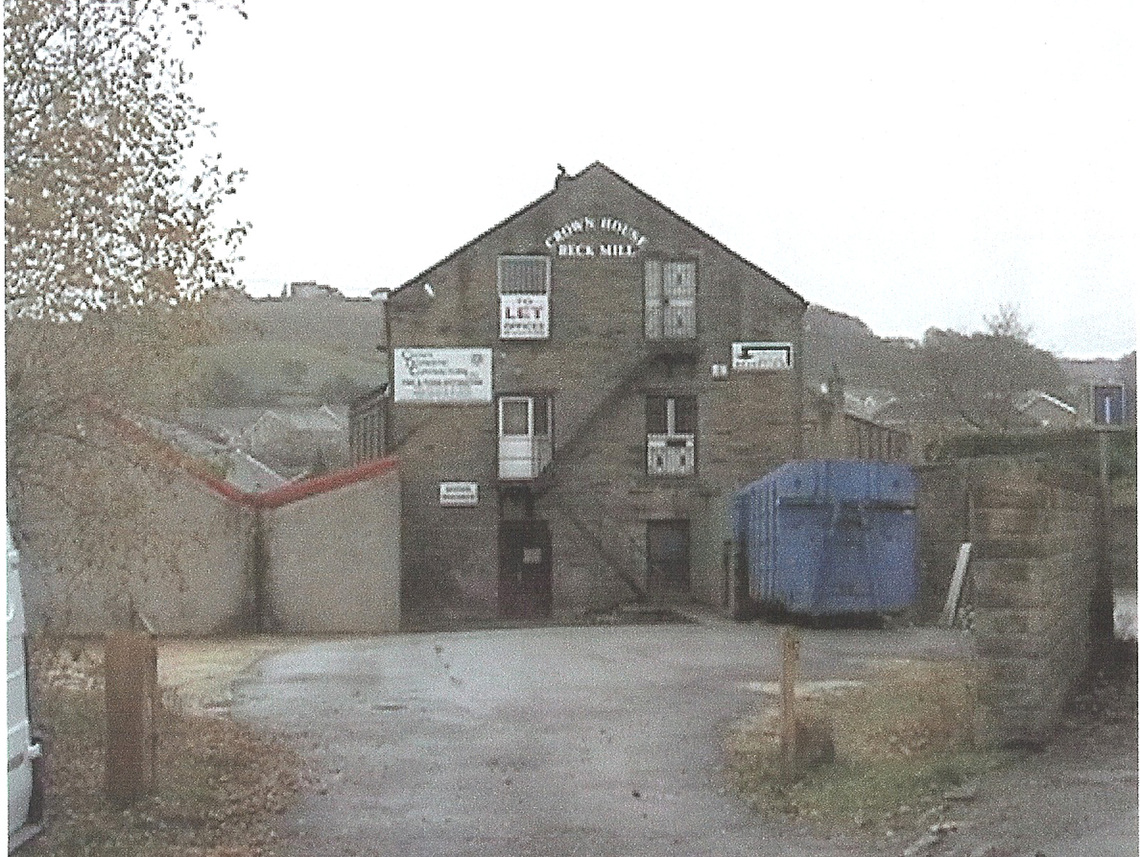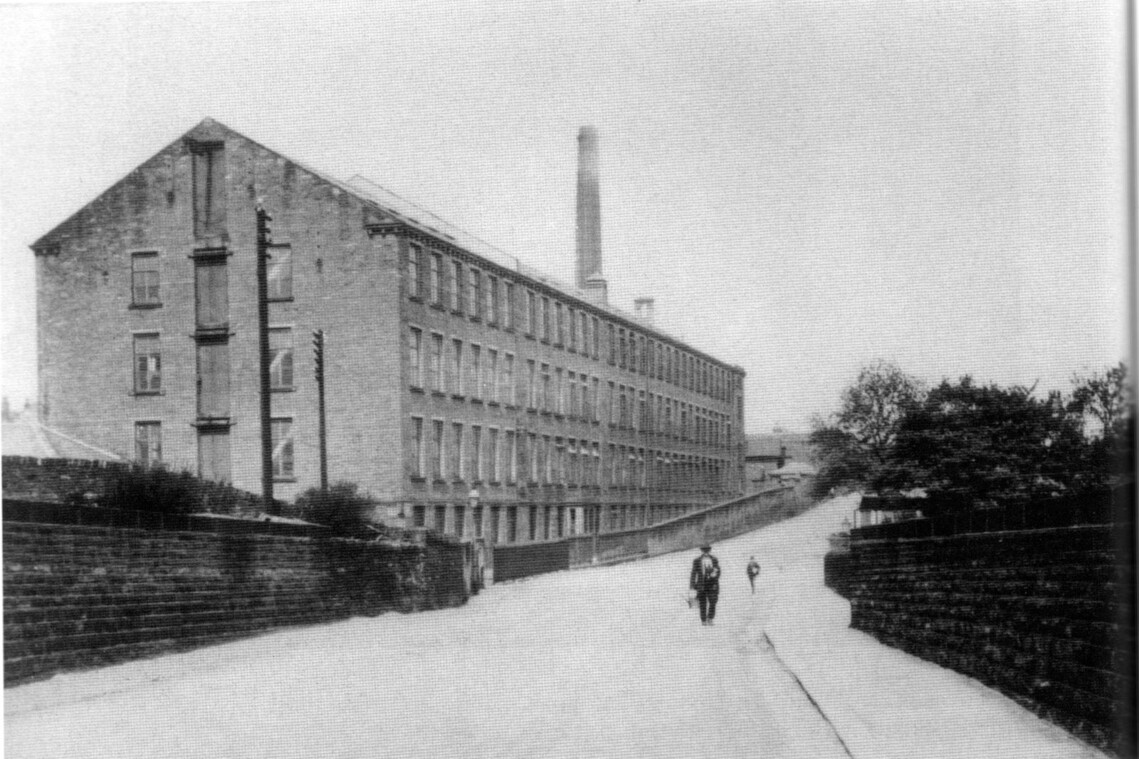Early HistoryClayton's textile industry was established in the 18th century, when hand loom weaving and spinning took place in the cottage's of villager's. Finished pieces would be sold in Bradford and at Piece Hall, Halifax. At the begining of the 19th century Clayton had over 1500 hand loom weavers working from home. With the advent of the industrial revolution and mechanisation, the work was transferred into a mill environment. The first mill to be built in the Clayton area was Brow Top Mill. The impact of mills on the population of Clayton can be seen by the following table of numbers employed. John Milner 1850 317 employees. Samual Barsdorf 1868 168 employees. Joseph Benn 1881 876 employees |
Brow Top MillBrow Top Mill was situated in a small valley below Brow Top Farm. Access for carts was via the lane and farm yard, or by foot, via a path leading from Raven Cottage, Brow Lane. A small stream fed the mill dam and this stream still meanders its was into Hole Bottom. The mill was built of stone and was only 75 feet long and 25 feet wide, it had three storey's and a warehouse extending over two cottages. Brow Mill was built by Timothy Wood about 1823 and in the late 1820's Timothy started a business as a worsted manufacturer, by 1830 he was bankrupt. In 1835 the mill was described as having an engine of 10 horsepower, eleven days work of land, cottages and a barn. In 1838 the mill was purchased by Joseph Fawthrop. 1854 was a disastrous year for business, due to the high price of wool and several small firms were ruined. Trade picked up but by 1858 bad times returned and Joseph decided to sell. In 1860 the newly formed busines of Joseph Benn and Co, leased the mill. The partners formerly employees of John Foster of Black Dyke Mills were Asa Briggs, Alfred Wallis and Joseph Benn. The company leased the mill for two years before moving to Beck Mill in 1862. The 1861 census shows Joseph Benn living in one of the mill cottages. From 1862 the mill was leased to several companies and was finally sold by the Fawthrops in 1873 to Jaques and Wright & Co. In 1878 it was sold to John Kershaw who in 1882 built West View House. In 1907 the mill and West View were again sold in parts to several people one of which was Sam Priestley of 2 Brow Cottages who puchased barns stables and mistals and No 4 Brow Top. The mill was now in decline and was used for a time as a rug making works in 1917. The ordnance survey map of 1921 shows the mill as derelict. The Mill was demolished in the early thirties and only a few stones remain to show its whereabouts. |
Beck or Holme MillJohn Milner was born in Clayton in 1788. He had worked all his life in the wool business. Finally at the age of 57 years he decided to start in business on his own and in 1845 he built Holme Mill. The mill was 50 yards in length and was two story`s high. The main engine house with a chimney 126 ft high and the offices fronted Occupation Lane, now Reva Syke Road. Over the road was a warehouse, communication between the mill and warehouse was by a covered elevated gangway. The land on which the mill was built was initially on lease and in 1845 it was purchased for the sum of £400. In 1856 John Milner tranferred the business to his son Ezra Milner. The business was known as Ezra Milner and Co. The firm had a comparatively short existence, ceasing trading in 1860 when Ezra purchased Pasture Side Farm. In 1862 the mill was leased to Soloman Barsdorf stuff manufacturer and to Joseph Benn & Co worsted manufacturers. 1n 1847 Holme House had been built by a James Green whose daughter married Ezra. This was a spacious mansion in the grounds of the mill, with ornamental gardens, glasshouse and fountains. Access by carriage, was by way of twin gates in Occupation Lane and a drive leading to the front door. The house at various time was leased to Soloman Barsdorf and Alfred Wallis prior to his move to Glenholme in 1888. In 1873 part of the garden had been purchased by J Benn & Co. Alexander Square was later built on this land. In 1869 Benn and Co were fined for polluting the beck. In 1879 John Milner died. In 1881 Joseph Benn started in business with his sons Alfred and Harrison, and in 1886 bought Beck Mills outright. Joseph Benn and Sons operated from both Beck and and later at Beckside Mills, Lidget Green. In 1882 Joseph Benn and Wallis / Briggs desolved their partnership. Joseph Benn and Co under the direction of Wallis and Briggs continued business at Oak mills only. There was no business connection between the two companies In 1889 a new 100ft mill extention and a 375 sq yd mill yard was built in the garden of Holme House, which saw its eventual demise. The house itself was converted into three separate apartments. It was demolished shortly after the 2nd World War. In 1926 J Benn and Sons tranferred complete production to Beckside Mills and since that date various smaller companies have used the premises. In 1971 a large section of the mill burnt down |
Oak MillsIn 1850, the area of Clayton which is now the estate comprising Jacobs Croft and Pinfold was known as Cowgill Fields. On Cowgill Fields was a row of houses called Coghill Row, (a derivative of Cowgill) which were administered by the Poor Law Board. In 1867 Joseph Benn and Co applied to the board to purchase the land in order to build Oak Mills. Permission was granted and the land was purchased. Building work commenced in 1868 and the mill was completed by August 1869 and was operational in 1870. The mill was 45 yds long and 20 yds wide and was four story`s high. At basement level was the yarn storage and packing departments, ground floor was for combing. 2nd and 3rd floor for spinning and the top floor for sorting. Attached to this building was the center part of the mill which was three story`s high and housed the engine room, boiler and mechanics workshop. Continuing toward Nursery Road was the shed, used for drawing and roving and some time later for weaving. Joseph Benn and Co continued to manufacture at both Oak and Beck Mills until 1881, when Joseph Benn left the partnership to form Joseph Benn and Sons. In 1882 Joseph Benn puchased Beck Mill and continued business there until 1926. In 1898 Asa Briggs retired fron the partnership leaving Alfred Wallis as sole owner. Alfred Wallis died on the 27th March 1913 aged 84, only 14 days after his wife. There son Frank Wallis inherited the business which continued to prosper. He died on the 27th December 1946, leaving an estate worth £1,096,402. In 1924 he had endowed a university scholarship of £2000 to deserving Clayton Students and many were the gifts to villagers and organisations. On the 6th October 1947 Oak Mills was sold to Jowett Cars Ltd for £50,000. On the 18th February 1954 the Mill was obtained by the British Wool Marketing Board. In 1999/2000 it was demolish for housing bringing to an end 130 years of history
|

